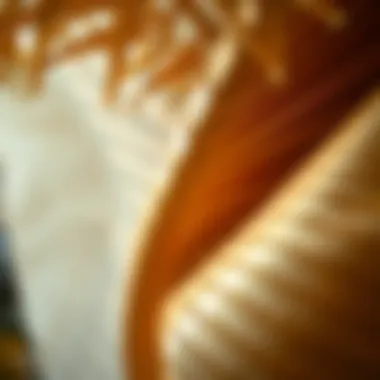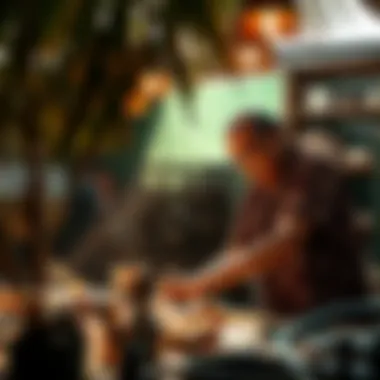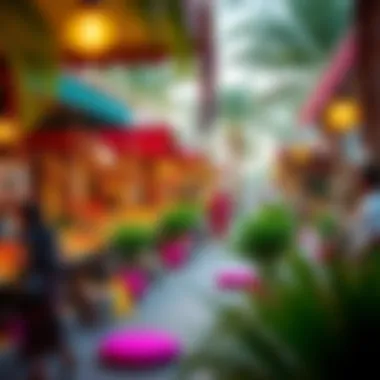Exploring the Intricacies of Palm Couture Fashion


Intro
Palm couture embodies a fascinating confluence of art and nature, revolving around the aesthetic brilliance found in palm trees and their ecosystems. This fashion subculture stands as a testament to human creativity, grounding itself in rich historical roots, cultural expression, and an unwavering commitment to sustainability. With communities flourishing in desert landscapes, the artistry behind palm couture reflects not only ancestral heritage but also contemporary innovation driven by local artisans.
As we embark on this exploration into palm couture, we will shine a light on its historical evolution, significance, and the role artisans play in transforming natural materials into stylish masterpieces. We will paint a vivid picture of how fashion not only serves as a source of identity but also resonates with environmental consciousness. Through various sections, readers can expect to uncover the intricate ties between culture, sustainability, and the fashion industry, specifically through the lens of palm couture that emerges in regions characterized by arid climates and lush greenery alike.
Curiously, the context within which palm couture is celebrated varies from one community to another. It draws inspiration from local customs, folklore, and the pressing need for adaptive, sustainable practices. The enduring spirit of environmental preservation pervades this fashion form, advocating for ethical methodologies in creation, be it through the utilization of organic materials or through supporting local craftsmanship.
Prepare to immerse yourself in a comprehensive guide that not only highlights the key themes of palm couture but also resonates with expatriates, tourists, locals, and real estate agents who are keen on understanding this unique fashion culture.
Foreword to Palm Couture
Palm couture is a fascinating blend of fashion and nature, where the elegance of palm trees informs the aesthetic choices of modern clothing. Understanding this unique fashion phenomenon provides insights into how culture, environment, and sustainability marry in unexpected yet profound ways. In this introduction, we explore what palm couture encapsulates, emphasizing its connection to the natural world and how that influences the style choices of communities and individual designers.
Defining Palm Couture
So, what exactly is palm couture? At its core, palm couture refers to fashion inspired by the striking forms, textures, and colors of palm trees and their adjacent environments. This movement represents more than mere visual appeal; it encompasses a lifestyle and philosophy that celebrates the outdoors. By integrating the intricate patterns and hues found in palm fronds into design elements, artists and designers create garments and accessories that resonate with their surroundings.
The term ‘couture’ itself points to the high level of craftsmanship involved in these designs. When we talk about palm couture, we are highlighting not only the materials that reflect the essence of palms but also the meticulous attention to detail that artisans pour into every creation.
Palm couture, therefore, becomes a narrative. Each piece tells a story—a connection to nature, cultural heritage, and, increasingly, a commitment to sustainable practices that seek to minimize environmental impact. This approach shakes hands with the modern ethos that prioritizes ethical fashion choices and ecological consciousness.
Importance of Nature in Fashion
Nature has long been a muse for designers, but the rise of palm couture underscores an essential trend: the growing necessity to blend fashion with environmental sustainability. It prompts one to reflect on how interdependent our lives are with the natural world. In palm couture, this goes beyond simple aesthetics; it embodies a lifestyle that promotes eco-friendliness and acknowledges the beauty of our natural surroundings.
In a world grappling with climate change and environmental degradation, prioritizing designs that celebrate our green spaces is more crucial than ever. By harnessing natural materials and employing sustainable techniques, palm couture can serve as a model for what the future of fashion might resemble.
Historical Context of Palm-Inspired Fashion
Understanding the historical context of palm-inspired fashion brings to light a significant layer of depth to this unique style. This exploration reveals how traditional elements and cultural exchanges have shaped and influenced contemporary palm couture. Recognizing these influences provides insights into the aesthetics and philosophies underpinning this fashion culture, allowing for a deeper appreciation of its nuances.
Cultural Roots and Influences
Palm couture draws heavily from the rich tapestry of traditions and symbols tied to palm trees, which have stood as iconic emblems in various cultures for centuries. In regions where these trees flourish, they often serve as more than just a backdrop; they’re woven into the very fabric of societal identity.
For instance, in Middle Eastern communities, the date palm carries deep cultural significance. Beyond its contributions as a food source, its fronds feature in traditional garments, reflecting both luxury and utility. The Palestinian thobe, an embroidered dress often adorned with motifs that resemble palm fronds, exemplifies this integration of nature into personal expression. Similarly, in parts of Africa, palm leaves are used to craft textiles, illustrating innovation in utilizing local resources.
Additionally, Asian cultures, such as those in Southeast Asia, have embraced palm designs in ceremonial attire. Here, the symbolism often intertwines with spiritual beliefs—each stitch and pattern tells a story of heritage and reverence toward the flora that thrives in their environment.
"The palm is not merely a tree; it is a cultural narrative manifesting through design and material use."
Evolution Over Time
The evolution of palm-inspired fashion showcases a remarkable journey from traditional handcraft to modern-day design ethos. Initially, garments were primarily functional, crafted to withstand arid climates while paying homage to the indigenous flora. As trade routes between East and West began to flourish, styles transformed.
Traders and travelers embarked on cultural exchanges that allowed intricate textile techniques to permeate various regions. For example, the sari in India evolved with the introduction of palm motifs, blending local craftsmanship with influences from Middle Eastern designs. Over time, palm aesthetics began appearing in haute couture, as designers such as Elie Saab and Giambattista Valli tapped into the elegance that palm-inspired patterns evoke.
Moreover, the proliferation of sustainable practices has propelled a resurgence in palm couture, as designers seek to embrace nature while combating environmental issues. Innovations like biodegradable materials woven with palm fibers signify the progress of fashion into a more eco-aware realm.
In summary, the timeline of palm-inspired fashion reflects a confluence of history, artistry, and nature, positioning it as a significant component of not just personal identity, but also of broader cultural narratives. The interplay between tradition and innovation continues to be pivotal, ensuring that palm couture remains a relevant and evolving aspect of global fashion.
Cultural Significance of Palm Couture
Palm couture stands as a fascinating intersection where art, culture, and fashion converge. Its significance burgeons within societies that hold palm trees dear, often viewing them not just as flora but as vital parts of their identity. These long-standing beings breath life and history, serving as symbols rich in meanings and narratives, preserving the soul of many communities. The cultural relevance is profound, as it illustrates how nature can be seamlessly woven into the fabric of daily life, making palm couture more than a mere fashion statement. It’s a tribute to traditions, a canvas for innovation, and a bridge between environmental awareness and contemporary style.
Symbolism of Palm Trees


Palm trees often symbolize growth, prosperity, and resilience. In various cultures, they are seen as a representation of paradise—standing tall against adversity and providing sustenance. For instance, in many Middle Eastern communities, the date palm is deeply intertwined with history, evoking a sense of place and belonging. It reflects the landscape and lifestyles, influencing everything from local food to clothing styles. The intricate patterns and structures often found in palm-inspired designs resonate with the natural geometry of these trees, creating a visual language that echoes their significance.
Moreover, palm trees can serve as a reminder of ecological balance. With the increase of sustainable practices in fashion, the palm tree has emerged as a key element, showcasing how natural materials can be used thoughtfully.
Palm Couture in Diverse Communities
Middle Eastern Influences
In Middle Eastern cultures, the influence of palm trees on fashion is profound. The use of palm fibers, for instance, is prevalent in various textiles. Artisans weave stunning garments that capture both contemporary aesthetics and traditional designs.
One key characteristic of Middle Eastern fashion is its emphasis on modesty. Loose silhouettes adorned with palm-inspired prints speak to both cultural norms and the practicality required in warm climates. Utilizing organic, locally-sourced materials not only supports local economies but also connects the designs back to the heritage of craftsmanship unique to this region.
However, there are challenges. The authenticity of the designs can often be diluted by global fashion trends, which may overlook the cultural significance behind these garments. Balancing honor and innovation is crucial.
Asian Adaptations
In Asia, palm couture finds a unique expression that markedly differs from the Middle Eastern interpretations. Here, the use of palm leaves and fibers can promote a harmony of traditional craftsmanship and modern artistry. Textiles like pandanus are uniquely suited for vibrant patterns that capture the eye and evoke the lushness of tropical landscapes.
A notable feature is the use of artisanal techniques, such as batik and tie-dye, infused with palm motifs, making them culturally relevant while appealing to contemporary trends. On the flip side, the global market can sometimes overshadow these local handicrafts with mass-produced alternatives, detracting from their authenticity and charm.
Western Interpretations
Western interpretations of palm couture tend to blend humour and chicness. Here, palm motifs are often seen on swimwear or casual summer wear, reflecting the laid-back, sun-kissed vibe associated with beach holidays. The critical aspect of Western adaptations lies in their commercial appeal and marketing potential. Brands often capitalize on the exotic allure of palm trees in their product designs.
Yet, this commercial success can blur the original meanings and significance connected to these designs. The challenge here resides in maintaining the delicate balance between trendiness and cultural sensitivity. Utilizing palm motifs solely for aesthetic purposes risks commodifying something deeply rooted in diverse cultures.
"Palm couture is not just fashion; it’s a narrative woven from the fibers of cultural heritage and natural aesthetics."
Relevant Links
- Wikipedia on Palm Trees
- Britannica on Culinary Uses of Palm
- Reddit Discussions on Palm Couture
- Fashion Sustainability Practices
- Artisan Techniques
This exploration of palm couture offers insights that go beyond mere aesthetics, urging for a deeper understanding of the cultural tapestries they represent.
Material Choices in Palm Couture
Material choices stand at the intersection of creativity and sustainability in palm couture. This unique fashion avenue does not just draw inspiration from nature; it harmonizes with it, choosing materials that resonate with both the aesthetic and the ecological ethos. In a world where environmental conversations are at the forefront, understanding the fabric behind palm couture provides crucial insights into its appeal and significance.
Natural Textiles and Sustainability
Natural textiles are the lifeblood of palm couture. The fibers used in these creations often come from renewable sources — cotton, linen, and even silk are traditional favorites. Textiles derived from palm leaves themselves, like palm fronds, might emerge as intriguing contenders. Their incorporation not only exemplifies creativity but also promotes a trust in sustainable practices.
Choosing natural over synthetic materials has manifold benefits.
- Biodegradability: Natural fibers break down more easily than their synthetic counterparts, leaving a smaller footprint on our planet.
- Breathability: In the scorching heat of desert landscapes where palm couture thrives, breathable materials ensure comfort for wearers.
- Aesthetic Appeal: Textures from natural materials often possess unique characteristics that give each piece a distinctive look.
Beyond just the choice of textiles, sustainability manifests in cultivation and sourcing practices. Local artisans often engage in eco-friendly methods, ensuring the preservation of plant species and promoting biodiversity. By opting for local sourcing, they cultivate relationships with their communities, further intertwining culture, heritage, and environmental stewardship.
"The essence of palm couture reflects an underlying respect for both craft and nature. It is a conversation that speaks not just to the eye but to the soul."
Innovative Approaches to Material Use
As fashion faces the mounting pressures of environmental scrutiny, innovation in material use is more critical than ever. Designers in palm couture are tapping into an array of novel approaches to material applications. One such method is upcycling, where discarded materials are resurrected to give life to new garments. Using leftover textiles avoids wastage while fostering creativity — a genuine two-for-one deal.
Moreover, advancements in technology are paving the way for the production of eco-fabrics. These materials not only avoid harmful chemicals during their production but also exhibit higher durability.
The resurgence of interest in sustainable practice has seen many designers incorporate:


- Recycled Fibers: Fabrics made from recycled plastics, such as ocean waste, directly tackle pollution while serving a dual function in fashion.
- Dyes from Nature: Instead of industrial dyes harmful to the environment, many artisans are experimenting with natural dyes derived from fruits, vegetables, and minerals, adding yet another layer of sustainability.
Innovation also extends to production techniques with a focus on reducing carbon footprints through local production. Many artisans choose to create their pieces in close proximity to their supply sources, which minimizes transportation emissions and supports local economies. This structured approach prompts a paradigm shift in the ways materials are used and perceived within palm couture, transforming a song of nature into a harmonious fashion symphony.
The Role of Artisans in Palm Couture
In the world of palm couture, artisans play a foundational role that extends beyond mere crafting. These skilled hands breathe life into designs, translating deep-rooted cultural narratives into wearable art. The synergy between tradition and innovation shapes not only the garments but the very essence of the communities that cherish them.
Craftsmanship often emerges as a cornerstone of this fashion culture. It is not just about the final product; it’s about the painstaking process involved in each stitch and every fold. Artisans bring with them a wealth of experience and expertise, often passed down through generations. This heritage lends authenticity to palm couture, making each piece a reflection of cultural identity and personal expression. While some might see fashion as a transient phase, in the realm of palm couture, it stands as a testament to enduring skills and rich narratives.
"Artisans are the storytellers of fabric, weaving narratives from threads that speak of their origins, beliefs, and aspirations."
Craftsmanship and Expertise
Delving deeper into craftsmanship, it must be understood that artisanship in palm couture fosters a dual respect for nature and skill. The meticulous attention to detail is evident in the selection of materials, often sourced locally to eliminate carbon footprints and promote sustainability. For instance, using palm fronds not only adds a distinctive texture to garments but also honors the landscape from which they come. This connection between the material and the maker exemplifies how artisans elevate palm couture into an eco-conscious movement.
The expertise of these artisans is not merely technical; it's also deeply personal. Many artisans participate in community workshops, sharing their knowledge and fostering a sense of belonging. One can observe that these gatherings do more than impart skills; they preserve local traditions while adapting to contemporary demands. This balance of preservation and innovation ensures that palm couture remains relevant, and that artisans remain at the forefront of its evolution.
Local Production vs. Global Distribution
The landscape of palm couture is fraught with nuances regarding local production and global distribution. While local artisans take pride in their handcrafted works, the expansion of global markets has introduced a dynamic tension in the sphere of palm couture.
On one hand, local production offers myriad benefits. Artisans using indigenous materials contribute to the economic stability of their communities. The craftsmanship is often a direct response to local demands, ensuring that the products resonate with cultural significance. Moreover, it supports small-scale economies, fostering a sense of pride and commitment to sustainability.
On the flip side, global distribution channels present both exciting opportunities and profound challenges. The reach of e-commerce and international fashion runways can introduce palm couture to broader audiences, sparking interest and appreciation worldwide. Yet, this comes with risks. There’s potential for cultural appropriation, where designs may lose their authentic essence as they become commodified or misrepresented.
Ultimately, striking a balance between local craftsmanship and the global market is essential. Creating pathways that allow artisans to tell their stories while introducing their work to international connoisseurs can pave the way for a more just fashion industry.
The future hinges on recognizing and celebrating the individual voices bound in each piece of palm couture, ensuring they resonate long beyond their origins.
Contemporary Trends in Palm Couture
In today's rapidly changing fashion landscape, palm couture emerges as a vibrant sphere where design is intimately woven with ecological awareness. This section delves into the contemporary trends that are reshaping palm couture, reflecting broader social shifts toward sustainability and cultural representation. These trends are not merely linked to aesthetics; they encompass crucial ethical and environmental considerations that resonate with an increasingly conscientious audience.
Influencers and Key Designers
Social media and digital platforms have reshaped the way fashion is disseminated and celebrated. Influencers and designers who focus on palm couture are at the forefront, melding the unique aesthetics of palm-inspired fashion with contemporary tastes. Designers like Chanel Dror from Naked Couture use palm motifs in their collections, crafting pieces that evoke the essence of tropical environments while remaining urban-friendly.
Moreover, influencers, such as Jessica Layton, showcase their favorite palm couture outfits on platforms like Instagram, integrating personal narratives with global awareness. They have ability to capture the imagination of a diverse audience, making palm couture accessible while honoring its roots. This blend of storytelling and fashion is particularly impactful, as it offers followers a glimpse into a lifestyle that values both aesthetics and ethics.
"Fashion is not just about what you wear, but how it makes you feel and how it connects to our world," says Chanel Dror, reflecting the ethos behind many of today’s palm couture designs.
Emerging Fashion Shows and Events
While traditional fashion weeks dominate the global stage, there has been a noteworthy rise in specialized events highlighting palm couture. Palm Springs Women’s Fashion Week, for instance, creates an intimate space for designers who emphasize eco-friendly practices drawn from local cultures. Here, artisans showcase not only garments but narratives that span generations.
In addition, collaborative events like Fashion for the Future celebrate local craftsmanship in palm couture, allowing designers to connect directly with their communities. These platforms provide a critical space for showcasing innovative ideas, and they emphasize the importance of returning to local materials that reflect environmental responsibility.
- **Key Events in Palm Couture: **
- Palm Springs Women’s Fashion Week
- Eco-Fashion Exposition
- Tropical Threads Show
As we grasp the pulse of these trends, it becomes evident that palms are more than just design motifs—they signal a broader cultural movement where community, sustainability, and style converge. Through influencer-driven narratives and emerging fashion events, the future of palm couture looks not only promising but also bright, connecting diverse communities with shared environmental values and innovative designs. As the world of fashion continues to evolve, the principles embedded in palm couture may lead to a more inclusive and environmentally aware industry.
Challenges Facing Palm Couture
As the world shifts its focus towards sustainable practices, palm couture must navigate a series of challenges to ensure its survival and evolution. Understanding these hurdles is crucial not just for designers but for communities that rely on the palm-inspired fashion culture. It brings awareness to the environmental strain and cultural preservation that accompany this artistic expression.


Environmental Concerns
One of the pressing hurdles for palm couture is its relationship with the environment. Since this fashion style often uses natural materials drawn from the palm trees themselves, over-harvesting poses a significant risk. In regions where palm trees are a staple, unchecked demand can lead to deforestation. This has repercussions not only for the ecosystem but also for local climates, which can become drastically altered.
The question arises, how do artisans balance the love for their craft with the need for environmental sustainability? Some brands have begun to adopt practices like the responsible sourcing of palms and actively engaging in reforestation efforts. This approach not only protects the vital tree but also ensures that the fashion created has a minimal footprint on our planet.
- Sustainable Material Use: It’s essential for designers to explore alternatives, such as using recycled materials or innovative textiles that mimic the look and feel of palms without causing harm.
- Educating Consumers: Encouraging consumers to make informed choices about their fashion can support the push for eco-friendly practices.
By advocating for these changes, the palm couture community can forge a way forward that aligns with both artistic integrity and ecological responsibility.
"The survival of palm couture in a sustainable way is not just about fashion; it’s about preservation of the very environment that inspires it."
Preservation of Cultural Identity
The intricate interplay between cultural identity and fashion cannot be overstated. Palm couture has deep roots in various communities across the globe, embodying traditions, stories, and values unique to each locale. However, as palm couture gains popularity, there exists a risk of diluting its cultural significance.
For instance, when mass production takes hold, authentic methods and cultural symbolism could be overshadowed. In this fast-paced age, maintaining the essence of these traditions becomes a delicate balancing act. Communities are faced with a difficult choice: should they embrace modern trends, or hold steadfast to their heritage? Striking this balance is essential for the continuation of palm couture as a meaningful cultural expression.
- Community Involvement: Encouraging local artisans to lead the narrative ensures authenticity remains at the forefront of palm couture.
- Promotion of Local Craftsmanship: Highlighting unique styles from specific regions can prevent homogenization, allowing each culture to retain its distinct identity.
Finding a way to honor the past while innovating for the future is key to fostering a vibrant ecosphere around palm couture. By doing so, communities can ensure that their unique styles are celebrated rather than lost in the tides of fashion trends.
Future of Palm Couture
As the world increasingly turns its gaze towards sustainability, the future of palm couture gains an even more significant role in the fashion landscape. The blend of artistic design with eco-conscious practices offers a promising horizon that meets the rising demand for responsible fashion. Not just an aesthetic choice, palm couture reflects a deeper commitment to preserving the environment and the culture tied to it.
Innovations in Design and Sustainability
The future of palm couture hinges on innovations that balance beauty with ecological responsibility. Designers are pushing boundaries, incorporating materials that minimize harm to our planet while embodying the essence of the palm tree, known for its durability and resilience. For instance, textiles produced from palm leaves, often found discarded, are now being crafted into elegant garments. This repurposing symbolizes a shift toward a circular economy in fashion—one that respects nature instead of exploiting it.
Moreover, technology plays a pivotal role in this transformation. Advances such as 3D printing and bio-fabrication allow for creating garments that are not only unique but also reduce fabric waste. Brands exploring algae-based textiles illustrate how innovation can yield both luxury and eco-friendliness. By adopting these practices, palm couture can set a benchmark in the fashion industry, demonstrating that you're not just wearing a piece of clothing, you're participating in a movement that respects the earth.
Potential Global Adoption
The allure of palm couture is not confined to its place of origin, with its elements finding their way into various fashion markets around the globe. Particularly in metropolitan areas, where fashion often dictates trends, the increased awareness of sustainable practices paves the way for broader adoption. When cultures intersect, the traditional designs rooted in palm couture meld with contemporary styles, creating a unique tapestry of fashion that appeals to a wider audience.
The possibility of global adoption comes with its benefits and responsibilities. It provides an opportunity for artisans and small-scale producers to thrive on an international platform, allowing them to showcase their craftsmanship while retaining the cultural stories behind their work. However, it also raises questions about cultural appropriation versus appreciation—a slippery slope that must be navigated carefully.
Palm couture's future is poised for excitement. As we stand on the cusp of this evolution, the commitment to sustainability and cultural preservation must be our guiding stars. Embracing this future can lead not only to more responsible fashion consumption but also to revitalizing communities that hold the key to palm couture's rich heritage.
"Fashion is not just about what you wear; it's about how your choices impact the world around you."
In summary, the landscape of palm couture holds immense potential for innovations that marry sustainable practices with breathtaking design. The global stage awaits the arrival of palm couture as it shifts from niche to mainstream, with the hope that it elevates not only fashion but also the lives of those who create it.
Culmination
The exploration of palm couture reveals more than just an artistic expression; it encapsulates a way of life that intertwines fashion with the rhythms of nature. As we've journeyed through the facets of this unique blend, it's clear that palm couture carries vital messages about sustainability, cultural identity, and innovation in fashion. The topic resonates with today's environmentally conscious audience, linking glamour with eco-friendly practices.
Recap of Key Insights
- Cultural Roots: The origins of palm couture draw from the rich traditions of desert communities, where the palm tree is not just a symbol, but a vital resource influencing clothing design.
- Sustainability Focus: The use of organic materials and local craftsmanship highlights a growing trend in fashion toward eco-responsible attire. This shift is a must-see, especially in a world more attuned to sustainable living.
- Continued Evolution: Even within contemporary contexts, palm couture continues to adapt and thrive, garnering attention on global stages and embracing new technology while keeping tradition in mind.
In essence, as we witness the furthering of eco-friendly initiatives, palm couture stands as a beacon of thoughtful fashion, challenging us to consider our relationship with nature in our everyday choices.
The Enduring Appeal of Palm Couture
There's an undeniable charm in the way palm couture captivates the imagination and inspires the senses, making it eternally relevant. The motifs and designs rooted in this fashion culture evoke memories of warm beaches and sunlit skies, creating a visceral connection to the outdoor world. Additionally, palm couture resonates with those who value identity in artistry. Each piece tells a story, a blend of heritage and modernity, which effortlessly charms the expatriate, tourist, and local alike.
For many, wearing palm couture is a statement—a way to showcase a love for sustainability while enjoying distinct aesthetic pleasure. Brands tend to draw from the deep symbolism of palm trees, representing growth, resilience, and tranquility. As such, choices in palm-inspired fashion reflect a thoughtful lifestyle, making it appealing to those seeking authenticity and purpose in their wardrobes.
Through its timeless qualities, palm couture has carved a niche that invites continual appreciation, ensuring its relevance long into the future.
"Fashion is not just what you wear; it's a reflection of where you come from and where you're going."
As the world transitions more toward eco-conscious living, palm couture offers a unique platform for expression—interwoven with cultural significance and a commitment to sustainability. With its roots firmly planted in tradition yet reaching upwards toward innovation, the allure of palm couture is certain to flourish in the seasons ahead.















